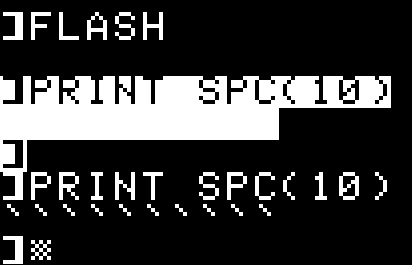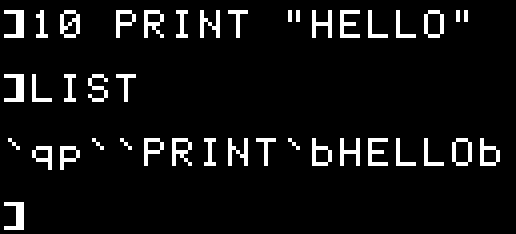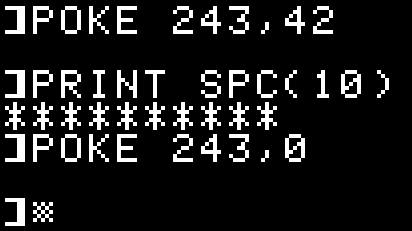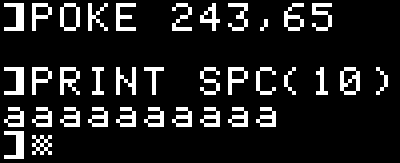| .. | ||
| README.md | ||
| spc1.png | ||
| spc2.png | ||
| spc3.png | ||
| spc4.png | ||
| spc5.png | ||
| spc6.png | ||
| spc7.png | ||
| spc_test.bas | ||
How to use SPC() to repeat any kind of character !
Introduction
You know how SPC() can be used to PRINT a number of space characters. For example PRINT SPC(10) will print 10 space characters.
Why didn't they allow to print something else than space characters ? It would have been interesting (?) to have the ability to repeat a sequence of any character.
Maybe something like PRINT REPT("*",10) could have printed 10 asterisks.
But Applesoft does not provide such an instruction. So are we doomed to use PRINT "**********"?
Here's a technique that will allow you to repeat any character, even in FLASH and INVERSE without using additional 6502 routines. And it's very easy to implement !
Discovery
Let's see something weird ...
 At the Applesoft prompt, type
At the Applesoft prompt, type FLASH.
Then PRINT SPC(10). You should now see 10 flashing space characters.
Now, press CTRL-RESET. This exits the "flash" mode (do no type NORMAL !!).
Type PRINT SPC(10) again. And ...
WOW ! WHAT IS THAT ??
What are those inverted single quote characters doing here ? "Something" has replaced space characters with those inverted single quotes ...
 If you have a loaded Applesoft program, I encourage you to
If you have a loaded Applesoft program, I encourage you to LIST it. If not, quickly type a short one and see the results ...
 And finally if you type an invalid command, the usual
And finally if you type an invalid command, the usual ?SYNTAX ERROR message will be a little different ...
As you can see, something is messed up !
Explanation
To understand what's happening here, you need to know how characters are printed on screen by Applesoft.
The Applesoft general routine to print characters on screen is in $DB5C and is named OUTDO.
Here's the routine, taken from S-C documentor website.
1950 * PRINT CHAR FROM (A)
1960 *
1970 * NOTE: POKE 243,32 ($20 IN $F3) WILL CONVERT
1980 * OUTPUT TO LOWER CASE. THIS CAN BE CANCELLED
1990 * BY NORMAL, INVERSE, OR FLASH OR POKE 243,0.
2000 *--------------------------------
DB5C- 09 80 2010 OUTDO ORA #$80 PRINT (A)
DB5E- C9 A0 2020 CMP #$A0 CONTROL CHR?
DB60- 90 02 2030 BCC .1 SKIP IF SO
DB62- 05 F3 2040 ORA FLASH.BIT =$40 FOR FLASH, ELSE $00
DB64- 20 ED FD 2050 .1 JSR MON.COUT "AND"S WITH $3F (INVERSE), $7F (FLASH)
DB67- 29 7F 2060 AND #$7F
DB69- 48 2070 PHA
DB6A- A5 F1 2080 LDA SPEEDZ COMPLEMENT OF SPEED #
DB6C- 20 A8 FC 2090 JSR MON.WAIT SO SPEED=255 BECOMES (A)=1
DB6F- 68 2100 PLA
DB70- 60 2110 RTS
The routine is called with the accumulator containing the character to print every time Applesoft needs to print something (like when using PRINT or INPUT or ... SPC !)
The routine that will effectively print the character on screen is COUT (in $FDEDhere named MON.COUT) but the OUTDO routine here is the pre-treatment of the character to print.
As you can see, before calling MON.COUT, an ORA with zero-page memory $F3 is executed. This ORA is needed to display characters in flash mode. The problem is that $F3, even after a CTRL-RESET is not reset and still contains $40 (decimal 64), meaning that Applesoft is still (partially -- see below why) in flash mode.
But if it's in flash mode, how comes it prints NORMAL single quotes and not flashing characters ? Because $F3 is just a mask and is not enough to flash the characters on screen. Another mask, in zero-page $32 is also used, but this time by the MON.COUT routine. In fact $32is usually considered to be the memory that indicates if we are in normal (value $FF, decimal 255), flash (value $7F, decimal 127) or inverse (value $3F, decimal 63) modes. But for the flash mode, the mask in $F3 is equally primordial. In fact, even in normal and inverse modes, the value in $F3 has an impact since the ORA is called whatever the display mode is.
So, before any character is displayed on screen by Applesoft, two masking operations occur on the ASCII value of the character.
- an
ORAwith the value in$F3 - an
ANDwith the value in$32
CTRL-RESET resets the value in $32 to 255 ("normal" display mode) but it does not touch the value in $F3. That's why we have these display glitches if we CTRL-RESET after FLASH.
Clearly, it's a bug.
When we press CTRL-RESET the system does a lot of resets, among them a call to SETNORM ($FE84) that restores the $32 memory to $FF. Then a bit later it calls the routine pointed by the reset vector ($3F2), that is Applesoft's warm restart in $E003 which in turns calls the RESTART routine in $D43C. This routine's main purpose is to display the ] prompt and wait for the user to type a series of direct commands or a line of code. The only way I see we could fix this bug is by pointing the reset vector in $3F2 to a small routine that would reset $F3 and then call the RESTART routine.
Taking advantage of what we know
Of course Applesoft expects and uses some specific values in $F3 and $32.
| NORMAL | FLASH | INVERSE | |
|---|---|---|---|
| $32 (50) | $FF (255) | $7F (127) | $3F (63) |
| $F3 (243) | $00 (0) | $40 (64) | $00 (0) |
Now, if we play a bit with the values in those two memory locations we will alter the way Applesoft displays characters on screen.
Two well-known (useless but kind of fun) examples are
POKE 243,32to lowercase everything, notably theLISTcommand.POKE 243,0will return to normal display.POKE 50, 128to sort-of disable printing.LISTandCATALOGwill appear empty and the]prompt will disappear as well.
Notice that POKEing in 243 influences only Applesoft and not the system ! That's because the ORA $F3 only occurs within an Applesoft 6502 routine !
So ... SPC() is an Applesoft display routine. And as such, it will be influenced by both the values in $32 and $F3. Now we just have to tweak those values to get expected results, that is, replace the space character by the character we want.
It turns out it's quite easy to do. You take the ASCII value of the character you want to display instead of the space character and you POKE it in 243 ($F3).
 For example, the asterisk has an ASCII value of
For example, the asterisk has an ASCII value of 42 (or $2A), so we just do POKE 243,42 and then PRINT SPC(10). After that we restore the original state with POKE 243,0.
Wow that was easy ! We now have a REPEAT instruction in Applesoft ! Oh yeah ?
Of course, there's a small caveat.
Remember that what happens behind the hood is that the space character ($20) is ORA'd with the value in $F3.
$20 ORA $2Aequals$2A. So, we're good.$20 ORA $61("a" lowercase character) equals$61. Still good. But ...$20 ORA $41("A" uppercase character) equals ...$61too ! Oh noo !
 In fact it will not work with ASCII characters from 64 to 95, those are the uppercase letters, the
In fact it will not work with ASCII characters from 64 to 95, those are the uppercase letters, the @ sign, the square brackets ][, the backslash \ , the caret ^ and the underscore _ .
But all is not lost since we also have an AND mask to apply ! For now, we assumed its value was $FF (255), meaning it has no effect. But what if ...
$20 ORA $41 ("A" uppercase character) equals $61 but if we do $61 AND $DF (thus clearing bit 5), we have $41 back !
So, for ASCII between 64 and 95, we have to change the value in $32 as well and it has to be $DF (223).

(Notice how I immediately typed the POKEs to restore the normal display, otherwise my next commands would be partially invisible.)
Now we are able to use SPC to repeat any character available !
One last thing ...
Ok, it works ... but only in NORMAL mode ! How do we make it work in FLASH and INVERSE ?
It's quite simple. I won't go into details on how it works but we just fiddle with the value in $32.
Basically what we do is subtract 128 ($80) from the value in $32 if we want FLASH characters and subtract 192 ($C0) if we want INVERSE characters.
It works because bytes in the text screen memory (in $400) do not use the ASCII values of the characters. Byte values between 0-63 will display INVERSE characters (no lowercase characters), while values between 64-127 will display FLASH characters (no lowercase characters). Values above 127 are NORMAL characters (upper and lowercase). Now 255-192=63 (INVERSE) and 255-128=127 (FLASH) ... I suppose you got it.
Remember that not all characters are printable in FLASH or INVERSE.
A little program to sum it all
This little program will demonstrate what we learned here.
It will fill the screen with one kind of character, using four SPC statements with a parameter of 240.
10 HOME
20 X = 255: Y=0: REM INIT VALUES
30 POKE 243,0: REM RESET ORA MASK
40 POKE 50, X: REM RESET AND MASK
50 VTAB 1
60 INPUT "ASCII (1-255; 0 EXITS) ? ";Z
70 IF NOT Z THEN END
80 INPUT "NORMAL/FLASH/INVERSE (N/F/I) ? ";N$
90 IF N$ = "F" THEN Y=128
100 IF N$ = "I" THEN Y=192
110 IF (Z>=64 AND Z<=95) OR (Z>=192 AND Z<=223) THEN X = 223: REM PREPARE END MASK FOR ASCII 64-95 OR 192-223
120 POKE 50,X-Y: REM SET NORMAL/FLASH/INVERSE MASK
130 POKE 243, Z: REM SET ORA MASK
140 VTAB 1
150 PRINT SPC(240): REM FILL THE SCREEN !
160 PRINT SPC(240)
170 PRINT SPC(240)
180 PRINT SPC(240)
190 GOTO 20

HAPPY CODING !
© 2021 François Vander Linden